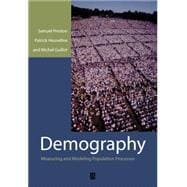
Note: Supplemental materials are not guaranteed with Rental or Used book purchases.
Purchase Benefits
What is included with this book?
Patrick Heuveline is Assistant Professor of Sociology and Research Associate of the Population Research Center at the University of Chicago. His recent work applies demographic analysis to such diverse topics as the Cambodian genocide and the HIV/AIDS pandemic.
Michel Guillot is a Post-Doctoral Fellow at the Harvard Center for Population and Development Studies, where his research focuses on formal demography and mortality in developing countries. He has a Ph.D. in Demography and Sociology from the University of Pennsylvania.
|
viii | ||||
|
x | ||||
|
xii | ||||
| Preface | xiv | ||||
| Acknowledgments | xv | ||||
|
1 | (20) | |||
|
1 | (1) | |||
|
2 | (1) | |||
|
3 | (2) | |||
|
5 | (2) | |||
|
7 | (1) | |||
|
8 | (7) | |||
|
15 | (1) | |||
|
16 | (2) | |||
|
18 | (3) | |||
|
21 | (17) | |||
|
21 | (3) | |||
|
24 | (4) | |||
|
28 | (3) | |||
|
31 | (1) | |||
|
32 | (3) | |||
|
35 | (3) | |||
|
38 | (33) | |||
|
42 | (2) | |||
|
44 | (3) | |||
|
47 | (1) | |||
|
48 | (1) | |||
|
48 | (3) | |||
|
51 | (2) | |||
|
53 | (6) | |||
|
59 | (2) | |||
|
61 | (3) | |||
|
64 | (1) | |||
|
65 | (6) | |||
|
69 | (2) | |||
|
71 | (21) | |||
|
71 | (2) | |||
|
73 | (5) | |||
|
78 | (2) | |||
|
80 | (4) | |||
|
84 | (2) | |||
|
86 | (3) | |||
|
89 | (3) | |||
|
92 | (25) | |||
|
93 | (6) | |||
|
99 | (2) | |||
|
101 | (5) | |||
|
106 | (7) | |||
|
113 | (4) | |||
|
117 | (21) | |||
|
117 | (1) | |||
|
118 | (1) | |||
|
119 | (10) | |||
|
129 | (2) | |||
|
131 | (2) | |||
|
133 | (1) | |||
|
134 | (1) | |||
|
135 | (1) | |||
|
136 | (2) | |||
|
138 | (33) | |||
|
138 | (3) | |||
|
141 | (3) | |||
|
144 | (3) | |||
|
147 | (3) | |||
|
150 | (5) | |||
|
155 | (6) | |||
|
161 | (6) | |||
|
167 | (4) | |||
|
171 | (20) | |||
|
171 | (1) | |||
|
172 | (4) | |||
|
176 | (4) | |||
|
180 | (2) | |||
|
182 | (2) | |||
|
184 | (7) | |||
|
191 | (20) | |||
|
192 | (9) | |||
|
201 | (3) | |||
|
204 | (4) | |||
|
208 | (3) | |||
|
211 | (13) | |||
|
212 | (2) | |||
|
214 | (1) | |||
|
215 | (9) | |||
|
224 | (32) | |||
|
224 | (9) | |||
|
233 | (8) | |||
|
241 | (2) | |||
|
243 | (3) | |||
|
246 | (10) | |||
|
256 | (17) | |||
|
256 | (1) | |||
|
257 | (2) | |||
|
259 | (7) | |||
|
266 | (4) | |||
|
270 | (1) | |||
|
271 | (1) | |||
|
271 | (2) | |||
| References | 273 | (12) | |||
| Index | 285 |
The New copy of this book will include any supplemental materials advertised. Please check the title of the book to determine if it should include any access cards, study guides, lab manuals, CDs, etc.
The Used, Rental and eBook copies of this book are not guaranteed to include any supplemental materials. Typically, only the book itself is included. This is true even if the title states it includes any access cards, study guides, lab manuals, CDs, etc.